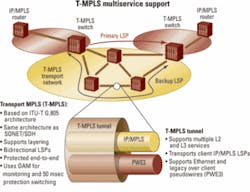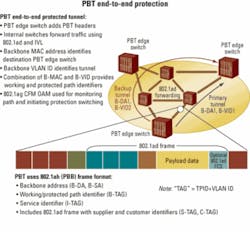T-MPLS and PBT/PBB-TE offer connection-oriented packet transport
by Daniel Joseph Barry
Provider Backbone Transport (PBT) and transport MPLS (T-MPLS) are two new packet-transport concepts that have re-ignited discussion on the best approach to implement a fully packet-based telecommunication network. Both concepts propose a connection-oriented, point-to-point packet transport method that provides a high-level of protection, monitoring, and control for network operators.
T-MPLS has been proposed and specified by several vendors-including Alcatel, Ericsson, Fujitsu, Huawei, Lucent, and Tellabs-and standardized by ITU-T over the past two years. PBT, on the other hand, has been proposed by Nortel and is expected to begin standardization in 2007 within IEEE as “PBB-TE” (Provider Backbone Bridging-Traffic Engineering). Other vendors such as Extreme, Meriton, Siemens, and World Wide Packets have recently voiced their support.
The main appeal of these concepts is the promise of lower cost, lower complexity, and ease of management, while providing an approach suitable for IP-based services that resembles existing, well-understood transport technologies.
The development of PBT and T-MPLS has been driven by a carrier need to migrate from existing SONET/SDH to a fully packet-based network that can easily scale to meet future bandwidth demands. IP-based services are expected to drive these demands. This factor has prompted many carriers to use IP/MPLS routers as the cornerstone of their migration strategies.
While some carriers have already migrated to a fully IP/MPLS-based network, others, particularly those with large existing SONET/SDH networks, are concerned with the implications of such a step. Since IP/MPLS is based on a network approach different from SONET/SDH, extensive retraining and work-process redesign would be required. There are further concerns that the complexity involved in configuration and maintenance of IP/MPLS routers will require highly skilled staff. These factors, combined with the cost of router interfaces, have prompted some carriers to seek alternatives.
Carrier Ethernet has gained traction recently as a connectivity method between routers that promises reduced cost and complexity. The widely understood benefits of Ethernet, such as ubiquity, simplicity, and low cost, and the fact that it can be implemented over multiple technologies have driven Carrier Ethernet’s appeal.
However, today most Carrier Ethernet networks are based on either Ethernet over SONET/SDH or Ethernet over MPLS (using pseudowires/virtual private line services). To date, Ethernet as a standalone transport mechanism has not been widely considered appealing due to its inability to meet carrier-class requirements.
PBT and T-MPLS provide a new alternative in which the former addresses the shortcomings of Ethernet while the latter addresses the complexity of IP/MPLS. Yet despite their different starting points, both are strikingly similar and address a key concern of carriers: how to migrate smoothly from an existing SONET/SDH transport to a fully packet-based network.
To understand the challenge of migrating from SONET/SDH transport networks, one has to understand the nature of transport networks.
Some of the crucial characteristics of transport networks include:
- Connections are set up infrequently, but have long holding times.
- Multiple, often critical, services are supported by one connection.
- These aspects require a high level of protection and availability.
- Quality-of-service mechanisms are required to ensure prioritization of critical services.
To ensure that these requirements are met, transport network operators require control and determinism. They want full end-to-end control of packet transport.
These requirements are at odds with the dynamic, autonomous, self-management of connection-less networks such as those based on IP/MPLS. Here, signaling protocols allow the network itself to determine, establish, and reroute paths through the network. Network management becomes reactive rather than proactive.
PBT and T-MPLS both provide a packet-based network approach that meets the requirements of transport networks outlined above. The key characteristics that both PBT and T-MPLS provide include:
- End-to-end, bidirectional point-to-point connections or tunnels that can support a number of packet-based services.
- Protection of these tunnels on an end-to-end basis with the ability to switch over in less than 50 msec.
- Assurance of OAM integrity on an end-to-end basis to support protection switching, fault detection, and monitoring of tunnels.
- Use of network management systems to control how tunnels are configured or provisioned.
With PBT and T-MPLS, it is now possible to envisage a migration from SONET/SDH where the operation of the network does not change dramatically, where extensive retraining is not required, and where existing work practices can be retained.
T-MPLS was the first attempt at realizing a transport-centric packet network. Standardized by ITU-T (in G.8110.1, G.8112, and G.8121) and based on ITU-T’s G.805 transport network architecture, it focuses on simplifying MPLS (mainly by eliminating the IP control plane) while adding the OAM and management functionality needed to meet transport network requirements.The premise of T-MPLS is that MPLS and its associated standards already provide the carrier-class mechanisms and maturity required to successfully implement the requirements of a packet transport network. The only issue to be addressed is the ability to maintain OAM integrity on an end-to-end basis, by removing IP specific, non-transport related functionality.
Thus, T-MPLS removes the following functionality, which impedes end-to-end OAM integrity:
- Penultimate hop popping: This mechanism pops the MPLS label at the penultimate node, sending IP packets to the last node. This eases the processing at the final node, but also means that MPLS OAM packets cannot reach this node.
- Label switch path (LSP) merging: In fast reroute MPLS link protection, it must be possible to merge two LSPs into one at a node. However, this can create problems in maintaining OAM integrity.
- Equal cost multiple path (ECMP): ECMP allows MPLS packets to be sent over multiple LSPs to the same endpoint. However, this makes OAM source identification and processing difficult.
By removing such functionality, OAM issues are resolved. The changes allow the use of the following transport mechanisms:
- Establishment of bidirectional, end-to-end LSPs.
- Use of ITU-T Y.1711 OAM-based mechanisms for monitoring and protection switching (Y.17tom and Y.17.tor under study).
- Use of ITU-T G.8131/Y.1382 linear protection switching for T-MPLS for 50-msec protection switching (based on Y.1720).
- Use of ITU-T G.8132/Y.1383 ring protection switching.
Figure 1 shows a typical T-MPLS network configuration. The T-MPLS network provides a primary and backup LSP where switching can take place within 50 msec. These T-MPLS “tunnels” can support both Layer 3 IP/MPLS traffic flows and Layer 2 traffic flows via pseudowires.
The first implementations of T-MPLS concentrate on point-to-point connections configured and monitored via a central network management system. However, work is underway to provide automation of configuration using GMPLS as a control plane (similar to existing OTN and SONET/SDH networks).
Until recently, the Ethernet protocol has not been considered as a viable independent transport mechanism. However, PBT promises to change that perception by addressing the key concerns associated with existing Ethernet implementations. These include:
- The limitations of the VLAN address space.
- The inefficiencies of broadcasting, flooding, and spanning tree (STP) protocols.
- End-to-end monitoring and 50-msec protection switching.
The IEEE 802.1ah MAC-in-MAC frame format is used to provide a very large address space with built-in layering. Building on Q-in-Q and independent VLAN learning, the customer, provider, and backbone domains are separated with their own addressing spaces (C-VID, S-VID, and B-VID). A new service identifier (I-TAG) is also included to clearly identify the end-to-end transport service. This approach greatly improves the scalability of Ethernet networks while enabling protection paths and service transparency.
Traditional Ethernet mechanisms for resolving unknown addresses have been criticized for not being able to scale to the demands of large WANs. Broadcasting and flooding are extremely inefficient on a large scale, while STP does not provide the robust protection switching capabilities required, even in improved versions such as Rapid STP (RSTP).
By turning off broadcasting, flooding, and STP, PBT avoids all of these issues. Forwarding tables in switches are populated and controlled via a central management center, but only on the edges of the network and only on initial configuration. Nodes internal to the network can continue to use IEEE 802.1ad provider bridging mechanisms to forward packets, making the use of “normal” Ethernet switches possible.The most important requirement, however, is the ability to provide an end-to-end transport path that can be protected and monitored on an end-to-end basis. Since Ethernet is a connection-less protocol, this concept has not been addressed to date. By using IEEE 802.1ag Connection Fault Management OAM packets, it is possible at the edges of the PBT tunnel to detect a fault and initiate a switchover to a predefined failover path.
Figure 2 illustrates a typical PBT network configuration, where the primary path is given by the combination of the backbone destination MAC address (B-DA) and the backbone VLAN ID (B-VID). The backup path has the same B-DA, but a different B-VID to indicate that this is another possible path to the same destination. Thus, multiple paths to the same destination could, in theory, be supported.
With all of these improvements, PBT provides characteristics that make it suitable for use in transport networks. As noted previously, PBT is currently not standardized, but is expected to be part of the IEEE’s PBB standardization under the name PBB-Traffic Engineering (PBB-TE). It is expected that this work will also consider GMPLS as a possible control plane for configuration, as in the T-MPLS case.
As can be seen above, T-MPLS and PBT are very similar as network concepts, both providing end-to-end, bidirectional point-to-point connections that can be protection switched in 50 msec and centrally managed. With either of these concepts it is now possible to address migration from SONET/SDH.
Deploying PBT and T-MPLS would keep existing transport network resources, work practices, and organizations intact while providing a packet-based network that can scale to meet future bandwidth demand.
Both technologies also provide an alternative to router deployment. Routers need only be deployed where Layer 3 capabilities are required with PBT or T-MPLS tunnels providing secure transport of data between routers.
This approach is very similar to existing SONET/SDH and OTN networks and provides an easier transition to packet networks for organizations that are familiar with these transport technologies. In this respect, PBT and T-MPLS are more a replacement for SONET/SDH than a competitor to IP/MPLS, and one can expect to see both connection-less IP/MPLS and connection-oriented packet transport-such as that which PBT and T-MPLS provide-coexisting in carrier networks.
Multicast remains an issue still to be addressed by both PBT and T-MPLS. At this time it is difficult to determine how much of an issue this will be, as current transport mechanisms do not support multicasting, yet support multipoint-to-multipoint client services. IPTV is viewed as the major driver of multicasting requirements-although it remains to be seen whether multicasting will occur in the transport network or closer to the last mile.
However, the true test of PBT and T-MPLS is yet to come. Performance in the field with documented savings in capex and opex will be the final determinants of the success of these concepts. In this regard, it is still far too early to say which will succeed. Yet in one sense they have already succeeded in altering our perceptions of packet-based networking and migration strategies, which will ultimately lead to the final solution: fully converged packet-based networks.Daniel Joseph Barry is director of marketing at TPACK (www.tpack.com).


